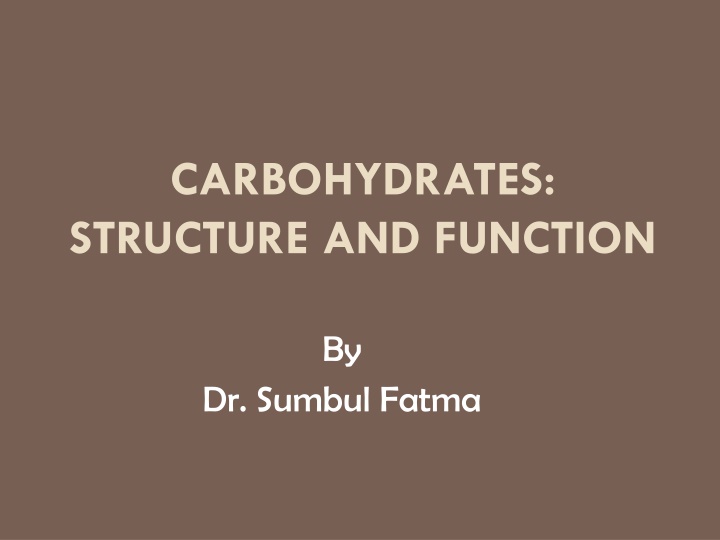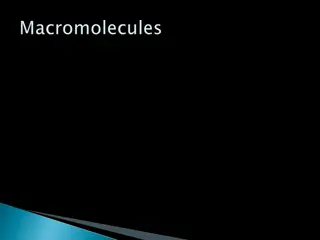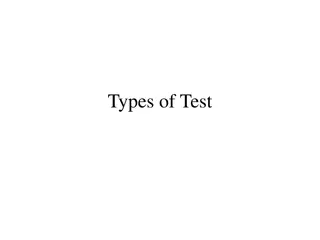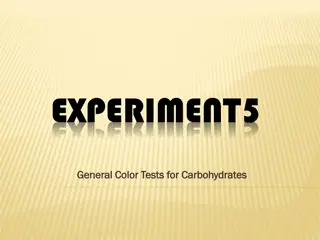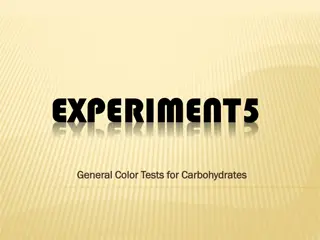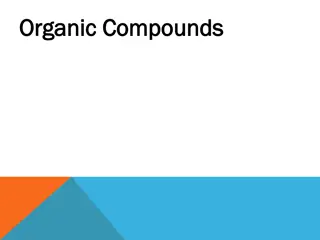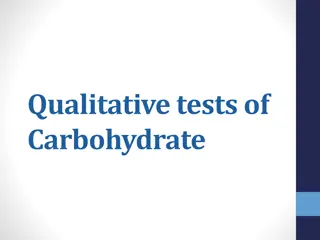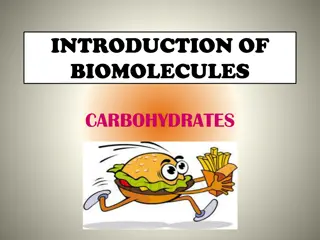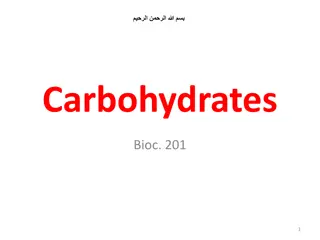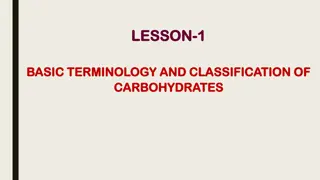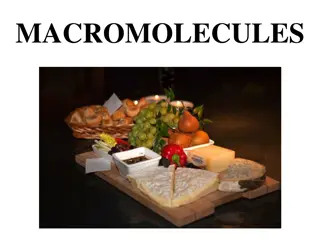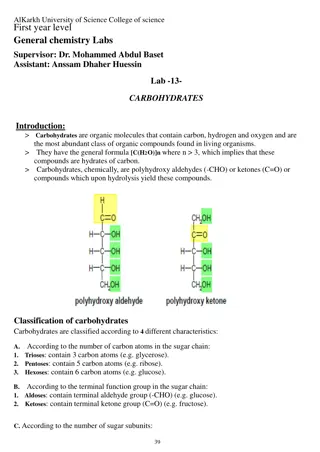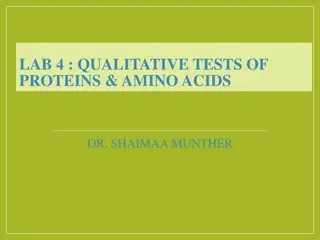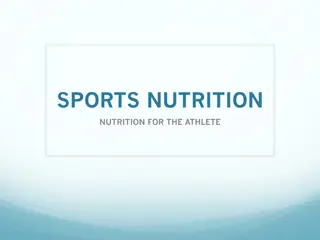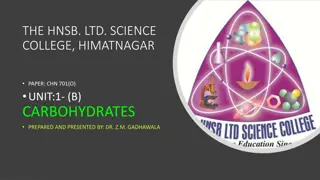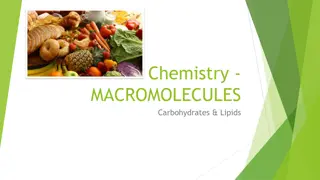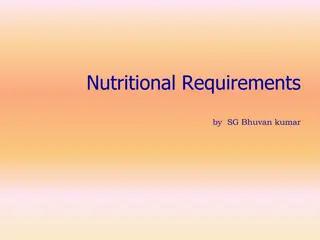Carbohydrates: Importance, Classification, and Tests
Carbohydrates are vital for human energy, serving as a major dietary component. This article discusses their importance, sources, chemical formula, classification by complexity and size, chemical properties, and testing methods like the Molisch test.
Download Presentation

Please find below an Image/Link to download the presentation.
The content on the website is provided AS IS for your information and personal use only. It may not be sold, licensed, or shared on other websites without obtaining consent from the author.If you encounter any issues during the download, it is possible that the publisher has removed the file from their server.
You are allowed to download the files provided on this website for personal or commercial use, subject to the condition that they are used lawfully. All files are the property of their respective owners.
The content on the website is provided AS IS for your information and personal use only. It may not be sold, licensed, or shared on other websites without obtaining consent from the author.
E N D
Presentation Transcript
CARBOHYDRATES: STRUCTURE AND FUNCTION By Dr. Sumbul Fatma
Objectives To understand: The structure of carbohydrates of physiological significance The main role of carbohydrates in providing and storing of energy The structure and function of glycosaminoglycans
OVERVIEW Carbohydrates: The most abundant organic molecules in nature The empiric formula is (CH2O)n, hydrates of carbon Carbohydrates: provide important part of energy in diet Act as the storage form of energy in the body are structural component of cell membranes
OVERVIEW CONT D Many diseases associated with disorders of carbohydrate metabolism including: Diabetes mellitus Galactosemia Glycogen storage diseases Lactose intolerance
CLASSIFICATION Monosaccharides: Simple sugar Disaccharides: 2 monosaccharide units Oligosaccharides: 3-10 monosaccharide units Polysaccharides: more than 10 sugar units Homopolysaccharides & heteropolysaccharides
Monosaccharides Further classified based on: 1. No. of carbon atoms 2. Functional sugar group: Aldehyde group aldoses Keto group ketoses
Monosaccharides CONT D Aldose Ketose Triose Glyceraldehyde Dihydroxyacetone Pentose Ribose Ribulose Hexose Glucose Fructose
Disaccharides Joining of 2 monosaccharides by O-glycosidic bond: Maltose ( -1, 4)= glucose + glucose Sucrose ( -1,2) = glucose + fructose Lactose ( -1,4) = glucose + galactose
Disaccharides CONT D Lactose Galactosyl- (1 4)-glucose
Polysaccharides Homopolysaccharides: Branched: Glycogen and starch ( -glycosidic polymer) Unbranched: Cellulose ( -glycosidic polymer) Heteropolysaccharides: e.g., glycosaminoglycans (GAGs)
Isomerism Isomers Compounds having same chemical formula but different structural formula
Aldo-Keto Isomers Example: Glucose (Aldose) and Fructose (Ketose)
Epimers Epimers CHO dimers that differ in configuration around only one specific carbon atom -Glucose and galactose, C4 -Glucose and Mannose, C2 Galactose and mannose are not epimers
Enantiomers (D- and L-Forms) Structures that are mirror images of each other and are designated as D- and L- sugars based on the position of OH grp on the asymmetric carbon farthest from the carbonyl carbon Majority of sugars in humans are D-sugars
- and -Forms CHO 1 H C OH 2 HO C H D-glucose (linear form) Cyclization of Monosaccharides Monosaccharides with 5 or more carbon are predominantly found in the ring form 3 H C OH 4 H C OH 5 CH2OH 6 6 CH2OH 5 6 CH2OH 5 O O H OH H H H H 1 4 1 4 H H OH OH H OH OH OH 2 2 3 3 H -D-glucose OH H -D-glucose OH -The aldehyde or ketone grp reacts with the OH grp on the same sugar CH2OH 1 C O 2 HO C 3 H -Cyclization creates an anomericcarbon (former carbonyl carbon) generating the and configurations CH2OH HOH2C O 6 1 H C 4 OH HO H 2 5 H C 5 OH H OH 4 3 H OH CH2OH 6 D-fructose (linear) -D-fructofuranose
Mutarotation In solution, the cyclic and anomers of a sugar are in equilibrium with each other, and can be interconverted spontaneously Fischer Projection Fischer Projection Haworth Projection
Sugar Isomers 1. Aldo-keto 2. Epimers 3. D- and L-Forms 4. - and -anomers
Reducing Sugars If the O on the anomeric C of a sugar is not attached to any other structure (Free), that sugar can act as a reducing agent Reducing sugars reduce chromogenic agents like Benedict s reagent or Fehling s solution to give a colored precipitate Urine is tested for the presence of reducing sugars using these colorimetric tests
Reducing Sugars CONT D Examples: Monosaccharides Maltose and Lactose
Complex Carbohydrates Carbohydrates attached to non-carbohydrate structures by glycosidic bonds (O- or N-type) e.g., 1. Purine and pyrimidine bases in nucleic acids 2. Bilirubin 3. Proteins in glycoproteins and proteoglycans 4. Lipids found in glycolipids
Glycosidic Bonds N-Glycosidic O-Glycosidic
Glycosaminoglycans (GAGs) Glycosaminoglycans (GAGs) are large complexes of negatively charged heteropolysaccharide chains are associated with a small amount of protein, forming proteoglycans, which consist of over 95 percent carbohydrate bind with large amounts of water, producing the gel- like matrix that forms the extracellular matrix The viscous, lubricating properties of mucous secretions also result from GAGs, which led to the original naming of these compounds as mucopolysaccharides
Glycosaminoglycans (GAGs) GAGs are linear polymers of repeating disaccharide units [acidic sugar-amino sugar]n The amino sugar (usually sulfated) is either D-glucosamine or D-galactosamine The acidic sugar is either D-glucuronic acid or L-iduronic acid GAGs are strongly negatively-charged: carboxyl groups of acidic sugars Sulfate groups
Resilience of GAGs Relationship between glycosaminoglycan structure and function Because of negative charges, the GAG chains tend to be extended in solution and repel each other and when brought together, they "slip" past each other This produces the "slippery" consistency of mucous secretions and synovial fluid When a solution of GAGs is compressed, the water is "squeezed out" and the GAGs are forced to occupy a smaller volume. When the compression is released, the GAGs spring back to their original, hydrated volume because of the repulsion of their negative charges This property contributes to the resilience of synovial fluid and the vitreous humor of the eye
Members of GAGs Examples of GAGs are: 1. Chondroitin sulfates: Most abundant GAG 2. Keratan sulfates: Most heterogeneous GAGs 3. Hyaluronic acid: Compared to other GAGs, it is unsulfated and not covalently attached to protein 4. Heparin: Unlike other GAGs that are extracellular, heparin is intracellular and serves as an anticoagulant
Take home Message Structure and function of carbohydrates Mono-, Di-, and Poly-saccharides Sugar Isomers: Aldo-keto, epimers, D- and L-, - and -anomers Complex carbohydrates: e.g., Glycosaminoglycans and proteoglycans Structure and function of GAGs Examples of GAGs: chondroitin sulfate, keratan sulfate, hyaluronic acid and heparin
